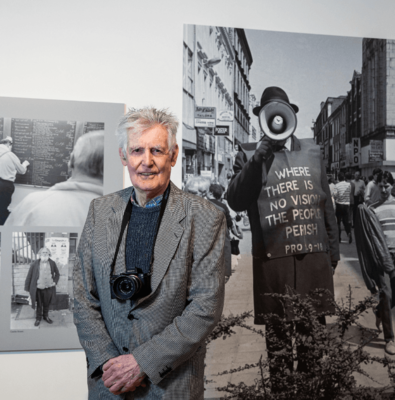WHAT helps an artist's legacy rise once they have died? Why do some artists receive posthumous acclaim while others of the same era lose visibility? This is something to consider when viewing the Arthur Armstrong Centenary exhibition at Carrickfergus Museum.
If you were not aware that Carrickfergus has a museum then we start off on the same foot – neither did I. However, the Arts Council has provided two of Armstrong's paintings to the Carrick collection and this chimed well with 2024 being the centenary of his birth to make an exhibition a fine idea. Art historian and dealer Dickon Hall was tasked with researching and assembling the artworks and at the opening he gave particular thanks to family and collectors who he said made it easy for him, noting also that the new exhibition will help that artist's legacy I mentioned.
Certainly, on looking at his credentials you would wonder why Armstrong is not more widely known. Born in Carrickfergus as the son of a house painter, he studied Architecture for two years at Queen's University then switched to study at Belfast School of Art. His early paintings in the exhibition depict a studio in a Belfast attic, a crumbling urban landscape and suggest influences of Cubism.
He travelled to England, France and Spain, eventually settling in Dublin, where he shared a house with fellow painter Gerard Dillon. One wonderful artefact in the exhibition is a book of phone numbers Armstrong and Dillon shared, with doodles on the cover by both artists.
Armstrong went on to exhibit internationally, including the United States, winning the Douglas Hurd Medal at the Oireachtas exhibition and becoming a member of the Royal Hibernian Academy and Aosdana in 1981. Previous to this, in 1969 he, Dillon and George Campbell designed the set of the Abbey Theatre's revival of Sean O'Casey's Juno and the Paycock.
Arthur Armstrong A Centenary exhibition Carrickfergus Museum until March 2025 open 10-4pm Monday - Saturday pic.twitter.com/1vSaAcvdVT
— Bronagh Lawson (@bronagh) November 8, 2024
There are some great paintings, prints and collages in the exhibition, showing the evolution of his style, including a period when he worked with plaster. The display cases containing his research material, including photographs of Connemara rocks and compositional drawings, are a real treat. It's hoped that this exhibition will inspire local young people to realise where a love of art – and a career in it – might take them. And of course it's a lasting contribution to his legacy. Well worth a trip along the coast to see.
Arthur Armstrong, A Centenary Exhibition, is at the Carrickfergus Museum and Civic Centre and runs until March 2025, Monday to Saturday 10am to 4pm
• Curator Hugh Mulholland at the Mac credits his dad, a gardener who always brought fresh flowers into the house and arranged them, as part of his inspiration for the exhibition 'I See His Blood Upon the Rose'. The show traces the history of flowers in art – their 'revolution from botanical illustrations to the opulent still life paintings of the 17th century, their adoption as symbols of political influence revolution, and human control over nature.'
Politically, they've been used as symbols of women's suffrage, the Easter Rising and opposition to the Vietnam War. Bernie Boston's iconic photo 'Flower Power', from October 22, 1967, is included in the exhibition. Taken during a protest at the Pentagon by the National Committee to End the War in Vietnam, it shows protester George Harris placing a flower in the barrel of an M14 rifle held by a soldier.
Central to the exhibition are historical pieces from Mary Delany, who lived in the 1700s, and Rachel Ruysch, a Dutch artist born in 1664 who developed a style of painting with great care, being as realistic as possible, even to the point of including real moss in her paint. Local artist Ted Pim has a series of large paintings in the Upper Gallery called 'The Butterfly Effect'. They dominate one wall and although you know they honour Dutch art history, they are very much contemporary. Seen alongside Paulo Bernardelli's video work in the Sunken Gallery of flowers blossoming and decaying, it's as if Pim has captured the movement of flowers in. his static paintings. Tracey Emin has a neon work included while Jennifer Trouton's painting competency stands up well to the added scrutiny of being hung next to Rachel Ruysch.
If you think it all sounds too traditional, it's not. Trinidad painter Alvero Berrington's works of flowers with electric hot stamens are framed in corrugated iron. Some of Jo Spence's collaboration with Terry Dennett over the last two years of her life living with leukaemia is also included.
'I See His Blood Upon the Rose' runs at the Mac until March 30, 2025, open from 11am to 5pm Tuesday to Sunday.
•Belfast School of Art continues its 175-year celebrations with an intensive couple of weeks focusing on 'Past, Present and Future'. See their website for details.









